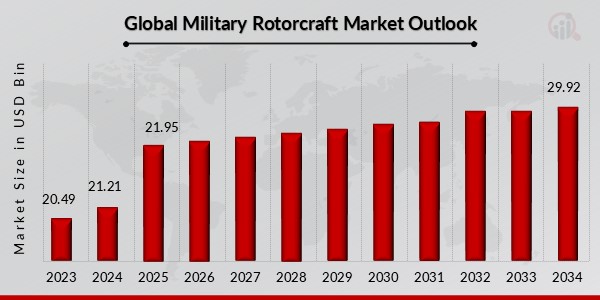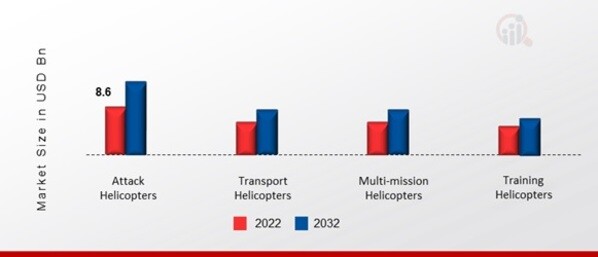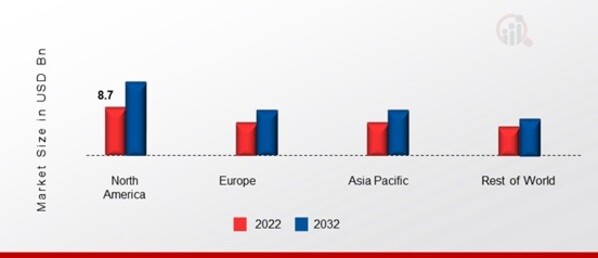Global Military Rotorcraft Market Overview
Military Rotorcraft Market Size was valued at USD 21.21 Billion in 2024. The military rotorcraft market industry is projected to grow from USD 21.95 Billion in 2025 to USD 29.92 Billion by 2034, exhibiting a compound annual growth rate (CAGR) of 3.50% during the forecast period (2025 - 2034). The primary market drivers propelling the market expansion include the need to replace old rotorcraft due to technological advancements, an increase in disasters, and an increase in territorial disputes.

Source Secondary Research, Primary Research, MRFR Database and Analyst Review
Military Rotorcraft Market Trends
Growing defense budgets is driving the market growth
The growing requirement for military modernization around the globe and the escalating defense budgets are two of the main factors propelling the military rotorcraft market. Globally, governments and defense agencies are investing large sums of money to improve their military prowess. This involves buying new military rotorcraft to replace outdated fleets and provide their troops with cutting-edge aircraft. The goals of modernization initiatives are to preserve a competitive edge, enhance operational effectiveness, and handle changing security risks and problems. Furthermore, the requirement for enhanced mobility, adaptability, and variety in military operations—all of which contemporary rotorcraft offer—is what motivates these expenditures. One of the main factors driving demand in the military rotorcraft market is the dedication to preserving and improving military capabilities.
The market for military rotorcraft is significantly influenced by growing worries about security for a number of reasons. The countries are prioritizing defense capabilities due to geopolitical pressures and the changing type of threats, such as terrorism and regional conflicts. With their adaptability and capacity to function in a variety of settings, rotorcraft prove to be invaluable tools for armed forces dealing with these intricate security issues. Furthermore, there is a greater need for rotorcrafts due to the necessity for quick response and mobility in a variety of situations, including disaster relief, counterterrorism, and peacekeeping duty. They are essential for handling evolving security threats due to their rapid access to difficult or inaccessible areas, search and rescue capabilities, and capacity to offer air assistance. In addition, the demand for military rotorcraft grows as nations need to update their defense systems. Maintaining a strategic edge and successfully responding to changing security problems requires upgrading outdated fleets with sophisticated rotorcraft outfitted with cutting-edge electronics, communication systems, and weaponry.
The military rotorcraft market is mostly driven by developments in rotorcraft design and technology. To improve the efficiency and capabilities of military rotorcraft, manufacturers are always coming up with new ideas in fields like aerodynamics, materials, avionics, and propulsion systems. These developments result in faster, more nimble rotorcraft that can transport larger loads. Furthermore, advancements in technology lead to the creation of rotorcraft with enhanced mission systems, endurance, and range. The effectiveness of missions and situational awareness are improved by the integration of sophisticated avionics, sensors, and communication systems. Military forces are keen to acquire contemporary rotorcraft that provide better performance and operational capabilities in order to keep a technological advantage over possible opponents. These developments in technology are major factors driving the military sector's need for modern rotorcraft. Thus, driving the military rotorcraft market revenue.
Military Rotorcraft Market Segment Insights
Military Rotorcraft Type Insights
The military rotorcraft market segmentation, based on type includes Attack Helicopters, Transport Helicopters, Multi-mission Helicopters, and Training Helicopters. The attack helicopters segment dominated the market. This is a result of attack helicopters being purchased to strengthen defensive capabilities in large quantities all around the world. Additionally, the expansion is a result of the widespread acquisition of attack helicopters by nations seeking to bolster their defense capabilities. For instance, the Nigerian government intends to purchase roughly 12 twin-engine assault helicopters to supplement the current fleet of attack helicopters. The country's counterterrorism and counterinsurgency efforts are anticipated to benefit from the new attack helicopters' improved capacity for search and rescue operations.
Figure 1: Military Rotorcraft Market, by Type, 2025 & 2034 (USD Billion)

Source Secondary Research, Primary Research, MRFR Database and Analyst Review
Military Rotorcraft Regional Insights
By region, the study provides the market insights into North America, Europe, Asia-Pacific and Rest of the World. The North American military rotorcraft market area will dominate this market. Because of significant defense spending and the presence of significant industrial competitors, the market in North America is still strong and resilient. The area's notable position in the market is further reinforced by its resolute dedication to technological progress and military modernization.
Further, the major countries studied in the market report are The US, Canada, German, France, the UK, Italy, Spain, China, Japan, India, Australia, South Korea, and Brazil.
Figure 2: MILITARY ROTORCRAFT MARKET SHARE BY REGION 2022 (USD Billion)

Source Secondary Research, Primary Research, MRFR Database and Analyst Review
Europe military rotorcraft market accounts for the second-largest market share. Europe offers a unique combination of traditional and modern rotorcraft designs due to its long history and ongoing advancements in military aviation. In addition to coordinated defense endeavors, the region's well-established aerospace industry has a major impact on market dynamics. Further, the German military rotorcraft market held the largest market share, and the UK military rotorcraft market was the fastest growing market in the European region
The Asia-Pacific Military Rotorcraft Market is expected to grow at the fastest CAGR from 2023 to 2032. The military rotorcraft industry in this region is growing significantly due to the efforts of nations like China and India. The market is expected to be pushed by the continued unrest throughout the world, threats to both internal and foreign security, fleet replacement programs, modernization strategies, and international territorial disputes. Moreover, China’s military rotorcraft market held the largest market share, and the Indian military rotorcraft market was the fastest growing market in the Asia-Pacific region.
Military Rotorcraft Key Market Players & Competitive Insights
Leading market players are investing heavily in research and development in order to expand their product lines, which will help the military rotorcraft market, grow even more. Market participants are also undertaking a variety of strategic activities to expand their footprint, with important market developments including new product launches, contractual agreements, mergers and acquisitions, higher investments, and collaboration with other organizations. To expand and survive in a more competitive and rising market climate, military rotorcraft industry must offer cost-effective items.
Manufacturing locally to minimize operational costs is one of the key business tactics used by manufacturers in the military rotorcraft industry to benefit clients and increase the market sector. In recent years, the military rotorcraft industry has offered some of the most significant advantages to medicine. Major players in the military rotorcraft market are attempting to increase market demand by investing in research and development operations includes Rostec, Lockheed Martin Corporation, Changhe Aircraft Industries Corporation, The Boeing Company, Textron Inc., Hindustan Aeronautics Ltd, Airbus SE, Leonardo SpA, Korea Aerospace Industries Ltd, MD HELICOPTERS Inc., Kaman Corporation, and Turkish Aerospace Industries Inc.
The Indian government owns Hindustan Aeronautics Ltd. (HAL), a business involved in aerospace and military. For the military and commercial markets, the business develops, plans, builds, and delivers aircraft, helicopters, avionics, and communications equipment. It also offers aircraft support, maintenance, and repair services. HAL provides aerospace equipment, innovative communication systems, navigational aids, and accessories for airplanes, helicopters, and aero engines. It provides services to the Mauritius Police Force, Boeing, Indian Army, Airbus Industries, Indian Navy, Defence Research & Development Organization, Indian Coast Guard, Indian Coast Guard, and Indian Space Research Organization.
The multi-industry corporation Textron Inc. (Textron) is involved in the aircraft, defense, industrial, and financial sectors. The company offers a wide range of products and services, including unmanned aircraft systems, land and marine systems, weapons and sensors, Beechcraft and Cessna aircraft sales and aftermarket services, Tiltrotor aircraft and related spare parts and services, Bell military and commercial helicopters, and aviation mission support products and services. In addition, it sells industrial goods such testing apparatus, golf carts, turf care vehicles, fuel systems, and functional components.
Key Companies in the military rotorcraft market include
- Rostec
- Lockheed Martin Corporation
- Changhe Aircraft Industries Corporation
- The Boeing Company
- Textron Inc.
- Hindustan Aeronautics Ltd
- Airbus SE
- Leonardo SpA
- Korea Aerospace Industries Ltd
- MD HELICOPTERS Inc.
- Kaman Corporation
- Turkish Aerospace Industries Inc.
Military Rotorcraft Industry Developments
For Instance, June 2022 The US Army and Foreign Military Sales (FMS) clients will receive a minimum of 120 H-60M Black Hawk rotors under a five-year contract that Sikorsky helped the US government secure. There are other possibilities to supply up to 255 aircraft.
Military Rotorcraft Market Segmentation
Military Rotorcraft Type Outlook
- Attack Helicopters
- Transport Helicopters
- Multi-mission Helicopters
- Training Helicopters
Military Rotorcraft Regional Outlook
- North America
- Europe
- Germany
- France
- UK
- Italy
- Spain
- Rest of Europe
- Asia-Pacific
- China
- Japan
- India
- Australia
- South Korea
- Australia
- Rest of Asia-Pacific
- Rest of the World
- Middle East
- Africa
- Latin America
Military Rotorcraft Report Scope
| Report Attribute/Metric |
Details |
| Market Size 2024 |
USD 21.21 Billion |
| Market Size 2025 |
USD 21.95 Billion |
| Market Size 2034 |
USD 29.92 Billion |
| Compound Annual Growth Rate (CAGR) |
3.50% (2025-2034) |
| Base Year |
2024 |
| Market Forecast Period |
2025-2034 |
| Historical Data |
2018- 2022 |
| Market Forecast Units |
Value (USD Billion) |
| Report Coverage |
Revenue Forecast, Market Competitive Landscape, Growth Factors, and Trends |
| Segments Covered |
Type and Region |
| Geographies Covered |
North America, Europe, Asia Pacific, and the Rest of the World |
| Countries Covered |
The US, Canada, German, France, UK, Italy, Spain, China, Japan, India, Australia, South Korea, and Brazil |
| Key Companies Profiled |
Rostec, Lockheed Martin Corporation, Changhe Aircraft Industries Corporation, The Boeing Company, Textron Inc., Hindustan Aeronautics Ltd, Airbus SE, Leonardo SpA, Korea Aerospace Industries Ltd, MD HELICOPTERS Inc., Kaman Corporation, and Turkish Aerospace Industries Inc. |
| Key Market Opportunities |
Rapid advancement in technology of rotorcraft |
| Key Market Dynamics |
Growing concerns about security Increasing spending on defense by government |
Frequently Asked Questions (FAQ) :
The military rotorcraft market size was valued at USD 21.95 Billion in 2025.
The market is projected to grow at a CAGR of 3.50% during the forecast period, 2025-2034.
North America had the largest share in the market
The key players in the market are Rostec, Lockheed Martin Corporation, Changhe Aircraft Industries Corporation, The Boeing Company, Textron Inc., Hindustan Aeronautics Ltd, Airbus SE, Leonardo SpA, Korea Aerospace Industries Ltd, MD HELICOPTERS Inc., Kaman Corporation, and Turkish Aerospace Industries Inc.
The attack helicopters category dominated the market in 2022.

















